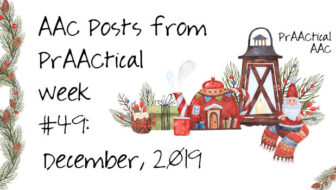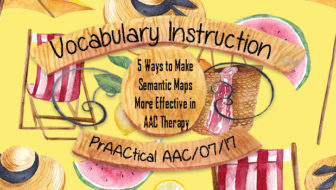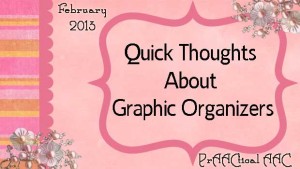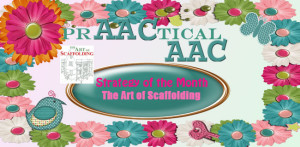December 8, 2019
by Carole Zangari -

Happy Sunday, AAC friends. Here are some posts that you may have missed in your busy week. Monday – Mindmapping Software/Apps for AAC Intervention Tuesday – AAC Link Up Wednesday – Video of the Week: Personalizing Core Vocabulary Systems Thursday – Developing a New AAC Resource: The TAT4AAC (Thinking About Thinking for AAC) ::::::::::::::::::::::::::::::::::::::::::::::::::::::::::::::::::::::::::::::::::::::::: Before you go, here are a few more posts to check out. Holiday Photos in AAC Learning: 3 Ideas for Using Them to Build Language It’s PrAActically Chanukkah! Holiday Talk: AAC Conversations Using Partner-focused Questions
Filed under: Featured Posts, PrAACtical Thinking
Tagged With: cognition, Graphic Organizers, holidays
July 17, 2017
by Carole Zangari -

Graphic organizers, such as semantic maps, are a well-established means of teaching word meanings. Both SLPs and educators frequently use this research-supported strategy to build word knowledge when working with AAC learners. Like any instructional tool or strategy, though, the learning gains our students make are tied to how we implement this kind of graphic organizer in our teaching and therapy. Here are some thoughts in maximizing the effectiveness of this powerful tool. Don’t expect graphic organizers to be the primary way that students learn their new vocabulary words. These tools are most effective when supplemented with other intervention strategies, like focused language stimulation. Make it interactive. While some professionals use graphic organizers as a worksheet that is completed in school or assigned as homework, that probably isn’t the best approach for AAC learners. Instead, plan to complete the graphic organizers WITH your student, so that you can guide the... [Read More...]
Filed under: Featured Posts, PrAACtical Thinking
Tagged With: Graphic Organizers, semantic instruction
November 26, 2013
by Carole Zangari -

Teaching language can be a sticky business. The concepts can be quite abstract, and that’s a challenge for many AAC learners. It can take some real thought to figure out how to simplify complexity. Beyond that, we have to teach in a way that helps learners retain the new information. Here are some of the things we think about when we’re running the our mental checklist of teaching options. 1. Graphic Organizers: There are so many ways to use graphic organizers to help simplify complex concepts. Use them to show relationships between things, sequences, and component parts. 2. Use a Story: Social narratives are somewhat like social stories, but don’t adhere to the same strict design parameters as a true social story. The TASN project in Kansas has almost 150 of them on a variety of topics on their website. You can check them out here. Most are in .doc,... [Read More...]
Filed under: PrAACtical Thinking
Tagged With: comprehension, contingency map, Graphic Organizers, social narrative, understanding
February 27, 2013
by Carole Zangari -

With our love of visually-based communication, it should come as no surprise that we were happy to come across this blog post by Ryan Knobloch. For starters, it’s always gratifying to see examples of how visual supports work for all types of learners in all types of situations. Making language visible is a good thing for all of us. Graphic organizers are one way to add clarity in AAC therapy sessions. It got us to thinking about how to make them accessible to learners with AAC needs by scanning them and making them into forms, for example. We also started reflecting on what goals could be supported through the use of this strategy. Semantic development and building stronger narrative skills immediately came to mind. Do you use graphic organizers in your work with AAC learners? We’d love to hear about it.
Filed under: PrAACtical Thinking
Tagged With: accessibility, Graphic Organizers
June 23, 2012
by Robin Parker -

“The best thing about being a teacher is it matters. The hardest thing is that it matters every day. All the time.” Todd Whitaker (Just substitute SLP’s for teachers since SLP’s are teachers of communication and language) As June ends and we finish up with our Strategy of the Month: Language Facilitation Strategies, we do not want to move on without talking about scaffolding. We often use scaffolding without even knowing we are doing it, but for speech-language pathologists, we need to know the name of each strategy we use because that allows us to make the most of everything we say and do when teaching communication and language. Also, when we know what we are doing, we can teach it to communication partners and thus set the stage for language learning at home, in school, and in the community. What is it? Scaffolding is a verbal and visual strategy... [Read More...]
Filed under: Strategy of the Month
Tagged With: Graphic Organizers, language facilitation strategy, Scaffolding




